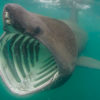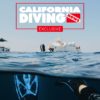Divers always want to know where the “best” spot is. Truth is there is no best spot as diver’s interests are as varied as the sites they dive. If you are looking for up-close and prolonged encounters with large animals, in particular manta rays, the spot you want to visit is a group of islands called the Revillagigedo Archipelago.
The Revillagigedo Archipelago is comprised of four islands: San Benedicto, Socorro, Roca Partida, and Clarion. Divers often refer to the Archipelago simply as “Socorro,” mainly to our inability to pronounce “Revillagigedo.” These islands are typically dived from a live-aboard charter boat on 9 or 12-day trips departing from Cabo san Lucas, and since Clarion is so far from the rest is only visited on the longer trips. San Benedicto is the closest and is about 230 miles away, and it takes around 24 hours to get there from the Cabo San Lucas harbor. The bottom around the islands of the Archipelago is relatively stark with a minimum of coral, invertebrates and plant life. This is not a place for those seeking little critters; it is a place to dive with the big boys.
Boats typically stop at the massive, volcano-topped San Benedicto for the first day or two. Here are two dive sites that will blow your mind. El Boiler is on the southwest side of the island and is a massive pinnacle that begins at about 20 feet and descends in steps to over 160. The honeycombed reef is riddled with giant green moray eels and lobsters. This is one of the busiest spots for the Pacific manta to be cleaned. The Clarion angelfish is the site’s most energetic cleaner and mantas, sometimes three or four mantas at a time, come in to be cleaned. Over the years the mantas have become incredibly comfortable with divers, and they view divers with a sense of curiosity and purpose. They seem to have a particular and unique fondness for bubbles. It is common to have a manta hover directly above a diver as they wiggle and jiggle in ecstasy as exhalation bubbles cascade across their belly. Manta encounters may last 20, 30 or more minutes with the mantas passing within a foot or so of divers.
On the southeast side of San Benedicto is El Cañón. This site consists of a horseshoe or box canyon-shaped group of pinnacles. The offshore side drops to 180 feet or so and the inshore floor is around 100. The dive consists of making your way to the lookout over deep water at 70-80 feet, and watch the fish go by. Schools of hammerhead sharks patrol the drop off and, unlike many other parts of the world, seem to have little fear of divers. This is a great place for prolonged encounters with hammerheads and for hammerhead portraits. There were also a few, very small and very cute silvertip sharks here. Divers are treated to close encounters with mantas during their safety stops.
Cabo Pearce is on the east side of Socorro, and is an underwater ridge running from shore out about 100 yards. Again this is a “porch-sitting” dive. Simply find a spot facing the current and watch the animals parade by. Manta rays, hammerhead, silky sharks, and schools of bottlenose dolphins are predictably photographed here. In April this year a mother and calf humpback whale passed directly over our heads and gave us a good view of the massive mother along with her tiny, 13-foot, baby.
Roca Partida is a massive pinnacle that sticks 20 feet or so out of the water. This is a relatively small site and divers can easily circumnavigate it twice on a single dive, currents permitting. If the currents are running you will need to stay in the upstream or downstream sides of the rock. At moderate depths there are several deep bowls in the rock that are normally filled with white tip sharks. There may be as many as a dozen, packed like cordwood in the small depressions. Again they are accustomed to divers and will often permit a close approach. Around the rock are silky and Galapagos sharks, and the occasional manta. We saw only individual silkies on this trip, but others reported swimming among a school of hundreds last season.
In 1994, the Mexican government established the Revillagigedo Archipelago “biosphere reserve” to protect this unique ecosystem. Since 2002, no fishing is permitted within 12 miles of the islands, and visitors are not allowed to set foot upon the islands. This was my third trip to the Revillagigedo Archipelago, and it has certainly changed for the better since my first dive some 20 years ago. The mantas are still there in great numbers and have not lost their curiosity of divers and their affection for their bubbles, but the other sharks are more plentiful and more curious of divers. In the old days we only saw a few hammerheads or silkies from a distance; now, we comfortably photographed them at close range.






